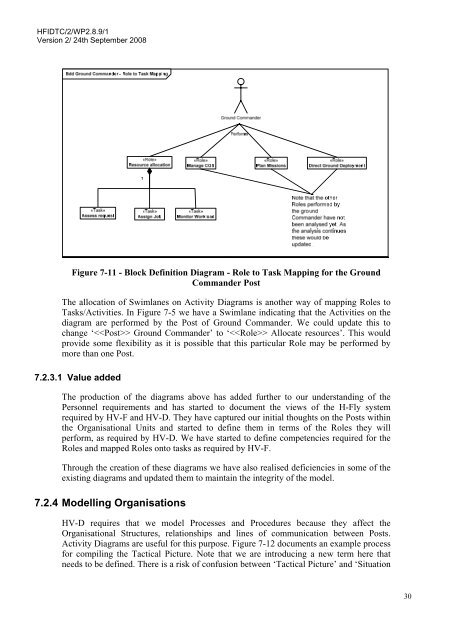Modelling Human Factors using the Systems Modelling Language
Modelling Human Factors using the Systems Modelling Language
Modelling Human Factors using the Systems Modelling Language
You also want an ePaper? Increase the reach of your titles
YUMPU automatically turns print PDFs into web optimized ePapers that Google loves.
HFIDTC/2/WP2.8.9/1Version 2/ 24th September 2008Figure 7-11 - Block Definition Diagram - Role to Task Mapping for <strong>the</strong> GroundCommander PostThe allocation of Swimlanes on Activity Diagrams is ano<strong>the</strong>r way of mapping Roles toTasks/Activities. In Figure 7-5 we have a Swimlane indicating that <strong>the</strong> Activities on <strong>the</strong>diagram are performed by <strong>the</strong> Post of Ground Commander. We could update this tochange ‘ Ground Commander’ to ‘ Allocate resources’. This wouldprovide some flexibility as it is possible that this particular Role may be performed bymore than one Post.7.2.3.1 Value addedThe production of <strong>the</strong> diagrams above has added fur<strong>the</strong>r to our understanding of <strong>the</strong>Personnel requirements and has started to document <strong>the</strong> views of <strong>the</strong> H-Fly systemrequired by HV-F and HV-D. They have captured our initial thoughts on <strong>the</strong> Posts within<strong>the</strong> Organisational Units and started to define <strong>the</strong>m in terms of <strong>the</strong> Roles <strong>the</strong>y willperform, as required by HV-D. We have started to define competencies required for <strong>the</strong>Roles and mapped Roles onto tasks as required by HV-F.Through <strong>the</strong> creation of <strong>the</strong>se diagrams we have also realised deficiencies in some of <strong>the</strong>existing diagrams and updated <strong>the</strong>m to maintain <strong>the</strong> integrity of <strong>the</strong> model.7.2.4 <strong>Modelling</strong> OrganisationsHV-D requires that we model Processes and Procedures because <strong>the</strong>y affect <strong>the</strong>Organisational Structures, relationships and lines of communication between Posts.Activity Diagrams are useful for this purpose. Figure 7-12 documents an example processfor compiling <strong>the</strong> Tactical Picture. Note that we are introducing a new term here thatneeds to be defined. There is a risk of confusion between ‘Tactical Picture’ and ‘Situation30
















